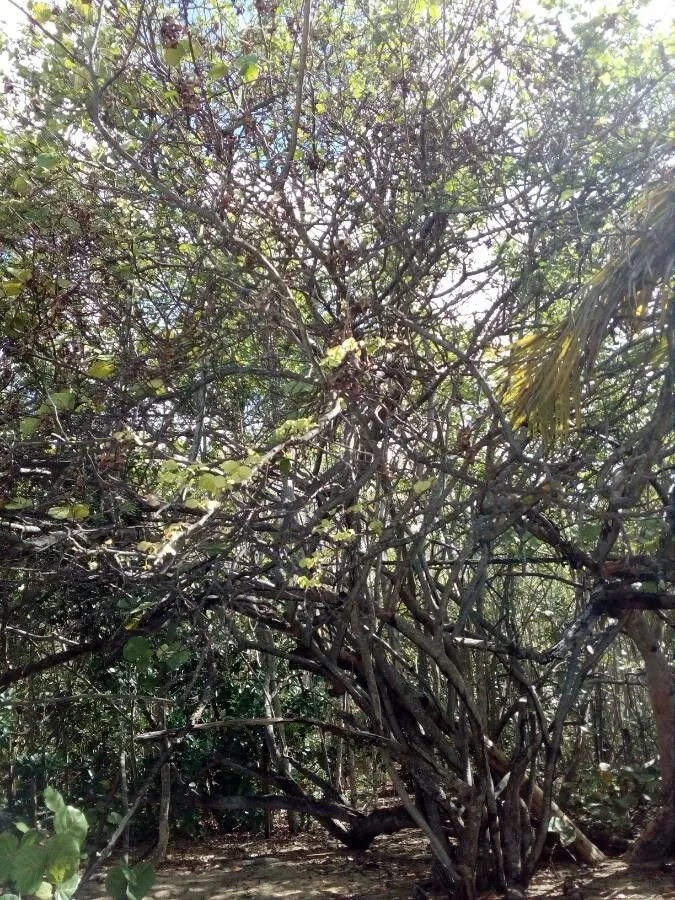
Author: (L.) Benth.
Bibliography: London J. Bot. 3: 200 (1844)
Year: 1844
Status: accepted
Rank: species
Genus: Pithecellobium
Vegetable: False
Observations: Mexico to Venezuela, Florida to Caribbean
Cat’s-claw, scientifically known as Pithecellobium unguis-cati, is a remarkable plant that belongs to the Fabaceae family. This plant is native to a wide geographical range that extends from Mexico to Venezuela and spans from Florida to the Caribbean. It is particularly noted for its tenacious climbing abilities, resembling a cat’s claw, which lends the plant its common name.
Discovered in the mid-19th century, Cat’s-claw was first extensively documented in 1844, as published in the London Journal of Botany. The notable botanist George Bentham, an authority on plant taxonomy, further classified and described this species. The name indicates its unique claw-like thorns which allow it to easily latch onto and climb various surfaces, creating dense foliage that provides excellent cover and can sometimes overwhelm native flora.
The Cat’s-claw serves various ecological roles in its native habitats. It thrives in tropical and subtropical environments and often grows in diverse ecosystems ranging from coastal forests to riverbanks. This versatile plant plays a crucial role in stabilizing soil, preventing erosion, and offering habitat and nourishment to local wildlife, especially pollinators such as bees and butterflies.
Botanically, the plant displays pinnate leaves that are glossy and deep green, contributing to its lush appearance. The characteristic flowers, which are typically white or pale yellow, emerge in delicate clusters. Following the flowering phase, the plant produces elongated, twisted pods that encase its seeds, facilitating its spread across the landscape.
The adaptive and widespread nature of Pithecellobium unguis-cati makes it a subject of interest not only for botanists but also for environmentalists and horticulturists. Its ability to grow in a variety of climates and conditions underscores its resilience and adaptive strategies, making it an interesting plant both in natural settings and for potential usage in managed landscapes.
Overall, the Cat’s-claw is a fascinating plant with a broad range of attributes that contribute to its unique standing in the plant kingdom. Whether admired for its ecological importance or studied for its botanical characteristics, it remains a significant species with enduring intrigue and value.
Spa: arranca pellejo, uña de gato
Eng: blackbead, cat’s-claw, catclaw blackbead, crab wood, money bush, moneybush
Fra: ongles de chat
En: Cat’s-claw, Blackbead, Catclaw blackbead, Bread-and-cheese, Crab Wood, Money Bush, Moneybush, Black Bead, Cat’s Claw, Catclaw Apes-earring
Fr: Ongles de chat, Griffe-chat, Bois traînant
Es: Arranca pellejo, Uña de gato, Guichiüi, Mochigüiste, Michigüiste, Una-de-gato
Taken Sep 20, 2022 by Marzanna Bug (cc-by-sa)
Taken Mar 18, 2021 by Sébastien TRASBOT (cc-by-sa)
Taken Nov 26, 2021 by Sonlight (cc-by-sa)
Taken Nov 14, 2013 by Tela Botanica − Liliane Roubaudi (cc-by-sa)
Taken Nov 14, 2013 by Tela Botanica − Liliane Roubaudi (cc-by-sa)
Taken Feb 24, 2017 by Tela Botanica − Liliane ROUBAUDI (cc-by-sa)
Taken Mar 15, 2018 by Tela Botanica − Liliane ROUBAUDI (cc-by-sa)
Taken Sep 14, 2022 by Ronny Rosillette (cc-by-sa)
Taken Aug 17, 2020 by Dr. A. G. Khatri (cc-by-sa)
Taken Mar 18, 2021 by Sébastien TRASBOT (cc-by-sa)
Taken Nov 6, 2022 by FRANCO CALDERON (cc-by-sa)
Taken May 16, 2021 by MaiteO (cc-by-sa)
Taken Dec 20, 2011 by Tela Botanica − Liliane Roubaudi (cc-by-sa)
Taken Jan 24, 2017 by Tela Botanica − Claire Felloni (cc-by-sa)
Taken Oct 31, 2022 by luanny ps (cc-by-sa)
© copyright of the Board of Trustees of the Royal Botanic Gardens, Kew.
© copyright of the Board of Trustees of the Royal Botanic Gardens, Kew.
© copyright of the Board of Trustees of the Royal Botanic Gardens, Kew.
Taken May 16, 2021 by MaiteO (cc-by-sa)
Taken May 6, 2021 by MaiteO (cc-by-sa)
Taken Mar 15, 2018 by Tela Botanica − Liliane ROUBAUDI (cc-by-sa)
Taken Mar 15, 2018 by Tela Botanica − Liliane ROUBAUDI (cc-by-sa)
Taken Mar 15, 2018 by Tela Botanica − Liliane ROUBAUDI (cc-by-sa)
Taken Feb 21, 2017 by Nelson Zamora Villalobos (cc-by-nc)
Taken Dec 8, 2007 by Tela Botanica − Liliane Roubaudi (cc-by-sa)
Taken Dec 20, 2011 by Tela Botanica − Liliane Roubaudi (cc-by-sa)
Taken Aug 29, 2022 by Julio Cardenales (cc-by-sa)
Taken Apr 20, 2008 by Tela Botanica − Marc Chouillou (cc-by-sa)
Taken Mar 18, 2021 by Sébastien TRASBOT (cc-by-sa)
Taken May 6, 2021 by MaiteO (cc-by-sa)
Taken Jan 28, 2021 by Henri JULIEN (cc-by-sa)
Growth habit>: Shrub, Tree
Family: Myrtaceae Author: (F.Muell.) K.D.Hill & L.A.S.Johnson Bibliography: Telopea 6: 402 (1995) Year: 1995 Status:…
Family: Rubiaceae Author: Pierre ex A.Froehner Bibliography: Notizbl. Bot. Gart. Berlin-Dahlem 1: 237 (1897) Year:…
Family: Sapindaceae Author: Koidz. Bibliography: J. Coll. Sci. Imp. Univ. Tokyo 32(1): 38 (1911) Year:…
Family: Asteraceae Author: A.Gray Bibliography: Pacif. Railr. Rep.: 107 (1857) Year: 1857 Status: accepted Rank:…
Family: Fabaceae Author: Medik. Bibliography: Vorles. Churpfälz. Phys.-Ökon. Ges. 2: 398 (1787) Year: 1787 Status:…
Family: Aspleniaceae Author: (Cav.) Alston Bibliography: Bull. Misc. Inform. Kew 1932: 309 (1932) Year: 1932…